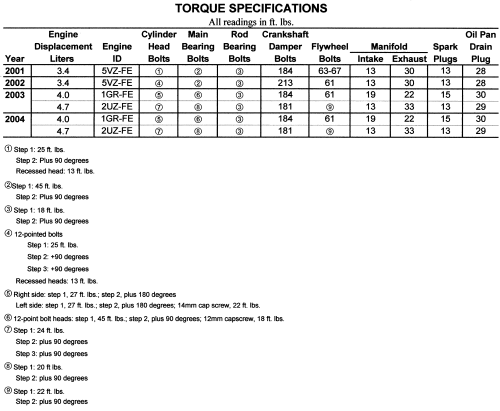The Power Behind The Badge: Understanding Toyota 4Runner’s Horsepower And Torque
The Power Behind the Badge: Understanding Toyota 4Runner’s Horsepower and Torque
Related Articles: The Power Behind the Badge: Understanding Toyota 4Runner’s Horsepower and Torque
Introduction
In this auspicious occasion, we are delighted to delve into the intriguing topic related to The Power Behind the Badge: Understanding Toyota 4Runner’s Horsepower and Torque. Let’s weave interesting information and offer fresh perspectives to the readers.
Table of Content
The Power Behind the Badge: Understanding Toyota 4Runner’s Horsepower and Torque

The Toyota 4Runner, a stalwart in the SUV segment, is renowned for its ruggedness, reliability, and off-road prowess. But beneath the robust exterior lies a powerful heart, measured in horsepower and torque – vital metrics that define the vehicle’s performance and driving experience.
Horsepower: The Measure of Power Output
Horsepower, often abbreviated as hp, quantifies the rate at which an engine can perform work. It essentially describes the engine’s ability to convert fuel into motion, resulting in the vehicle’s acceleration and top speed. A higher horsepower figure indicates a more powerful engine, capable of propelling the vehicle with greater force.
Torque: The Force that Gets You Moving
Torque, measured in pound-feet (lb-ft), represents the twisting force an engine generates. It’s the force that gets the vehicle moving from a standstill and helps it climb hills or tow heavy loads. Higher torque figures translate to quicker acceleration, better towing capacity, and a more responsive driving experience, particularly at lower engine speeds.
The Toyota 4Runner’s Powertrain: A Journey Through Generations
The 4Runner’s horsepower and torque figures have evolved over the years, reflecting advancements in engine technology and the changing demands of the market.
1984-1995: The Dawn of a Legend
The first generation 4Runner, introduced in 1984, was powered by a 2.4-liter four-cylinder engine generating a modest 96 hp and 120 lb-ft of torque. While not a powerhouse, it provided adequate performance for its time.
1996-2002: A V6 Revolution
The second generation 4Runner, launched in 1996, marked a significant shift with the introduction of a 3.4-liter V6 engine. This engine offered a substantial power boost, delivering 183 hp and 217 lb-ft of torque, making the 4Runner more capable on and off the road.
2003-2009: Refining the Formula
The third generation 4Runner, introduced in 2003, retained the 3.4-liter V6 but further refined its output, generating 190 hp and 220 lb-ft of torque. This generation also saw the introduction of a 4.7-liter V8 engine for the SR5 and Limited trims, producing a more impressive 270 hp and 315 lb-ft of torque, enhancing the 4Runner’s towing capabilities.
2010-2013: Embracing Efficiency
The fourth generation 4Runner, launched in 2010, saw the 3.4-liter V6 replaced with a more efficient 4.0-liter V6. This engine delivered 270 hp and 278 lb-ft of torque, achieving a balance between power and fuel efficiency. The V8 engine remained an option, offering 315 hp and 327 lb-ft of torque.
2014-Present: The Modern 4Runner
The current fifth generation 4Runner, introduced in 2014, continues to utilize the 4.0-liter V6 engine, generating 270 hp and 278 lb-ft of torque. This engine, known for its reliability and durability, offers sufficient power for most driving scenarios. The V8 engine was discontinued, focusing on fuel efficiency and a more refined driving experience.
Understanding the Impact of Horsepower and Torque on the 4Runner
The 4Runner’s horsepower and torque figures are crucial in determining its performance characteristics, influencing its acceleration, towing capacity, and overall driving experience.
Acceleration and Performance:
Higher horsepower figures translate to quicker acceleration times, allowing the 4Runner to swiftly gain speed. This is particularly important for merging onto highways or overtaking other vehicles.
Towing Capacity:
Torque plays a critical role in towing, as it provides the force needed to move a heavy load. The 4Runner’s torque figures determine its maximum towing capacity, which can vary depending on the engine and trim level.
Off-Road Capabilities:
Torque is essential for off-road driving, allowing the 4Runner to navigate challenging terrain with ease. Higher torque figures provide the necessary power to climb steep inclines and tackle rocky obstacles.
Fuel Efficiency:
While horsepower and torque contribute to performance, they also impact fuel consumption. Higher horsepower and torque figures generally require more fuel, making it essential to consider fuel efficiency when evaluating the 4Runner’s powertrain options.
FAQs on Toyota 4Runner Horsepower and Torque
Q: What is the horsepower and torque of the current Toyota 4Runner?
A: The current Toyota 4Runner is powered by a 4.0-liter V6 engine that produces 270 hp and 278 lb-ft of torque.
Q: How does the 4Runner’s horsepower and torque compare to its competitors?
A: Compared to other mid-size SUVs, the 4Runner’s horsepower and torque figures fall within the average range. However, its focus on off-road capabilities and towing capacity sets it apart from some competitors.
Q: Does the 4Runner offer a turbocharged engine option?
A: The current Toyota 4Runner does not offer a turbocharged engine option. Its powertrain focuses on naturally aspirated engines known for their reliability and durability.
Q: Is there a significant difference in performance between the different 4Runner trims?
A: While all 4Runner trims share the same 4.0-liter V6 engine, there might be slight variations in performance due to different gear ratios and weight distribution based on the trim level’s features and equipment.
Q: How can I improve the 4Runner’s horsepower and torque?
A: While there are aftermarket modifications available to enhance the 4Runner’s horsepower and torque, it’s crucial to consult with a reputable mechanic to ensure compatibility and maintain the vehicle’s reliability.
Tips for Maximizing the 4Runner’s Power
1. Regular Maintenance:
Ensuring regular maintenance, including oil changes, air filter replacements, and spark plug inspections, helps maintain the engine’s optimal performance and ensures maximum horsepower and torque output.
2. Fuel Quality:
Using high-quality fuel, as recommended by the manufacturer, helps optimize engine performance and fuel efficiency, contributing to a more responsive driving experience.
3. Driving Habits:
Avoiding aggressive acceleration and heavy braking can improve fuel efficiency and reduce wear and tear on the engine, ultimately contributing to better power output over time.
Conclusion
The Toyota 4Runner’s horsepower and torque figures are key factors that contribute to its reputation as a capable and reliable SUV. While the 4Runner may not boast the highest horsepower figures in its class, its balanced powertrain, coupled with its rugged build and off-road prowess, make it a compelling choice for drivers seeking a versatile and capable vehicle. Understanding the importance of horsepower and torque helps drivers appreciate the 4Runner’s strengths and make informed decisions when choosing the right trim level and configuration to meet their specific needs.
![]()

![]()



![]()
![]()
Closure
Thus, we hope this article has provided valuable insights into The Power Behind the Badge: Understanding Toyota 4Runner’s Horsepower and Torque. We thank you for taking the time to read this article. See you in our next article!
You may also like
Recent Posts
- The 2025 Toyota 4Runner: A Legacy Reimagined
- The Enduring Appeal Of The Toyota 4Runner Manual Transmission 4×4
- The Toyota 4Runner TRD Off-Road: A Legacy Of Adventure, Reimagined For 2025
- The Anticipation Builds: Unveiling The Next Generation Toyota 4Runner
- The 2025 Toyota 4Runner TRD: A Legacy Of Adventure Reimagined
- The Future Of Color: Exploring The Significance Of Color Trends
- The Toyota 4Runner: A Legacy Of Capability, Now With Expanded Seating
- The Toyota 4Runner Timing Belt: A Vital Component For Engine Longevity
Leave a Reply